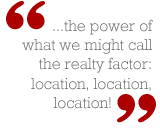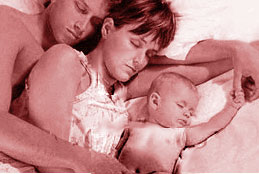






|
Contact
Contact is vital for close relationships. Without initial contact, there is no possibility of a relationship, of course. But
beyond initial contact, repeated encounters determine whether the two wish to see even more of each other. For example, suppose you meet
someone new at a social event. A few days later, you run into each other at the video store: you apparently live in the same
neighborhood. Polite hellos are exchanged. A few days after that, you find you are both killing time at the same laundromat; now a
longer conversation ensues. You run into each other on a regular basis now that you have met and recognized each other, and with each
encounter the conversation is easier, you have more things to talk about: trivial things like trouble with the change machine at the
laundromat; common interests such as finding you both like videos with the same actors.
Proximity and contact are the vehicles by which you exchange information, and each encounter makes your interaction less like the
"any warm body" affiliation and a bit more like "picky" attraction.
Notice that this type of contact -- running into each other in stores, bars and classrooms -- doesn't require that two people to
actually live near each other, only that they frequent the same locations. But frequent, unplanned meetings are easier and more
probable when the two parties live in close proximity or work in the same building. Distance poses a challenge; it makes random contact
unlikely. When people live farther apart, their interactions must be planned or they might not happen.
Attention: There's a "homework" assignment later in this session that's designed to help you figure out ways to expand your opportunities to meet people by
subtly shifting the locations you frequent.
A few years ago, in a class discussion about interpersonal attraction, one male student told his tale of woe, that he was giving
up on what had been a promising relationship with a woman he liked because, "although I really like her and enjoy being with her, it's
too much of a hassle, 'cause she's 'G.U.'" I asked, of course, what "G.U." meant. "Geographically undesirable," he replied with a
straight face, continuing, "She lives 30 miles north of campus and I live 30 miles south. It takes too much time and travel to see her.
I need to find someone closer to home."
Running into someone on a regular basis increases your opportunities to learn about each other, first with polite eye
contact, later with small talk and eventually entire conversations. From such simple interactions, real closeness is built.
Attraction and Dormitory Design
After World War II, many ex-servicemen attended colleges and universities thanks to the G.I. Bill veterans' benefits. Schools
everywhere had to construct dormitory space for young men and sometimes young families. At M.I.T., former military barracks,
intended to be temporary wartime facilities, were adapted to work as tiny apartments for these students.
Researchers Leon Festinger, Stanley Schachter and Kurt Back, seeking to understand attraction and liking, saw this sudden occupation of so many identical buildings as a sort of neighborhood
laboratory for the study of friendship formation. They asked these dorm residents to report on how and with whom they had made friends
among their classmates. Surveys questioned them about what they might have in common with new acquaintances: branch of military they
served in, current family structure, major in school, favorite pastimes, location of home town and so on.
What emerged was the power of what we might call the realty factor: location, location, location! The men reported their closest
friends were those to whom they lived closest. More intriguingly, in cases when some apartments were equally close to a unit next door
and one just upstairs, the best friend wasn't the one next door, but the neighbor who shared a stairway. It was the frequency of
contact, created by the "design" of the dormitory, that consistently predicted friendship choices for these men.
Architectural features of living spaces do force some people to interact with certain others. If you live in a multi-story apartment
building, for example, the level of your apartment and your distance from an exit or elevator may affect how well you and your neighbors
know -- and like -- each other. Every resident, wherever his or her apartment, must use the first floor on leaving or arriving home.
Those who live on the first floor are more likely to be seen and to have contact with all others in the building. Likewise, those who
live near exits, elevators and stairways are put in the path of other residents. In contrast, those who live down the hall, away from
entrances and on higher floors are less likely to see and be seen. Your very popularity and social opportunities may be dependent on
where you happen to have been assigned a room or apartment!

Where do you go in the course of the day? How likely are you to encounter others when you are there? Size up the place-popularity of
your own weekly routine.
On a sheet of paper, sketch space for two columns of 10 or more lines each. In the first column, list at least 10 places you visit
every week, on a regular basis in the course of your work and personal life: school, office, parking deck, church, shops,
restaurants and so on. Now in the second column, for as many of the first items as possible, list an alternative you do not visit
as often but where you could go for the same or similar purposes -- a different grocery store, a different restaurant where you might dine, etc.
Now go back and look at each item in the first column: rate each of the places you visit on a scale from 1 to 5 in terms of its contact potential , the average
number of new people -- people you don't already know -- whom you are likely to actually see or encounter there. This means making eye contact or having the chance to
exchange a few words. Ratings for Column 1 places go like this:
- 1 = you encounter 0-1 new persons per visit
- 2 = you encounter 2-4 new persons per visit
- 3 = you encounter 5-8 new persons per visit
- 4 = you encounter 9-12 new persons per visit
- 5 = you encounter more than 12 new persons per visit
Note that an "encounter" is not the same as simply being in the same place with other people. On a train station platform, for
example, you might share space with hundreds of others, but how many could you really meet and greet?
After you've listed your ratings for Column 1, revisit the items that you rated relatively low. Then look at the alternative. Would
the alternative shop or restaurant merit a higher rating? If not, can you think of still other alternatives that might offer you more
frequent chances for social contact?
The point of this exercise is to examine your environment in terms of the relationships it offers. You visit different locations in the
course of your life and activity; some offer more opportunities to meet, greet, and like others than do the alternative locations. If
you feel you are "popular enough" or have plenty of friends already, this may just be an interesting exercise for you. But if you have
ever longed for social contacts or intimate relationships you don't currently have, then a reevaluation of your "place potential" is in
order! Plan now to explore new places, break out of the rut of frequenting only the same places for commerce and fun. Consider too
whether your very living situation is cutting you off from social contact instead of accessing it. Perhaps you might relocate to a
living space that is busier, noisier -- but also more popular!

|



